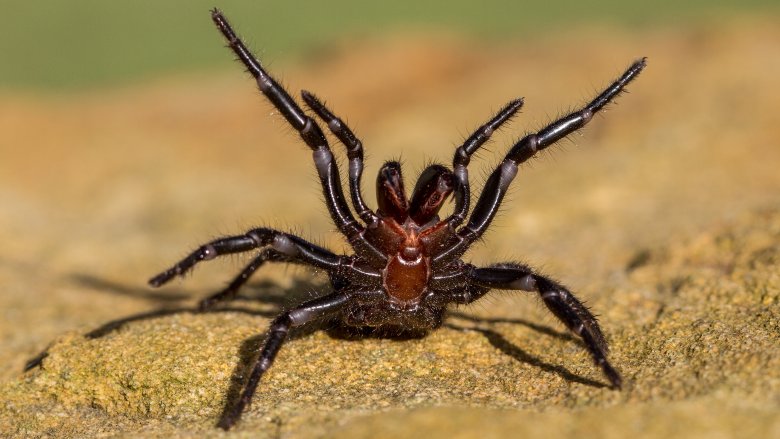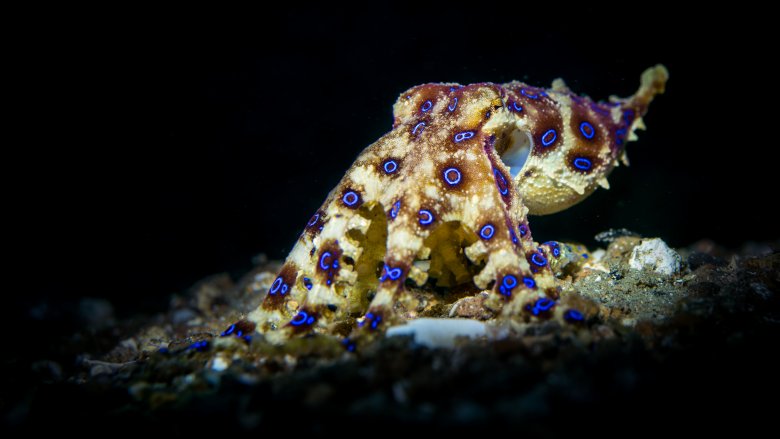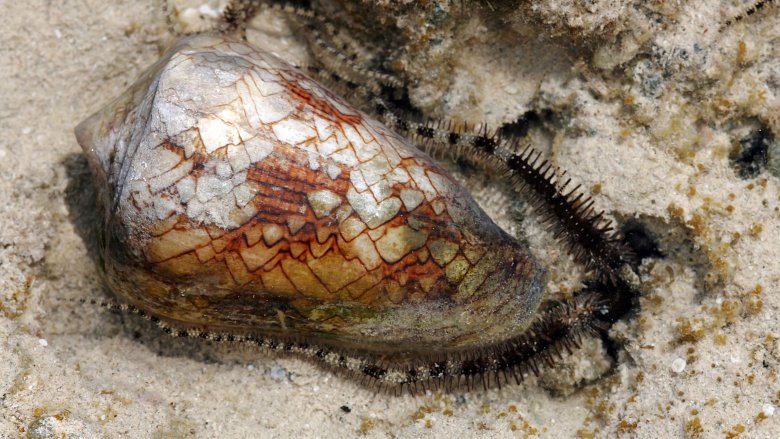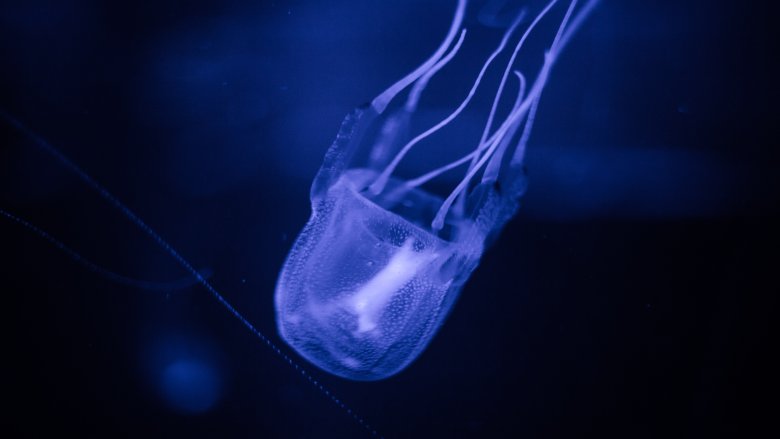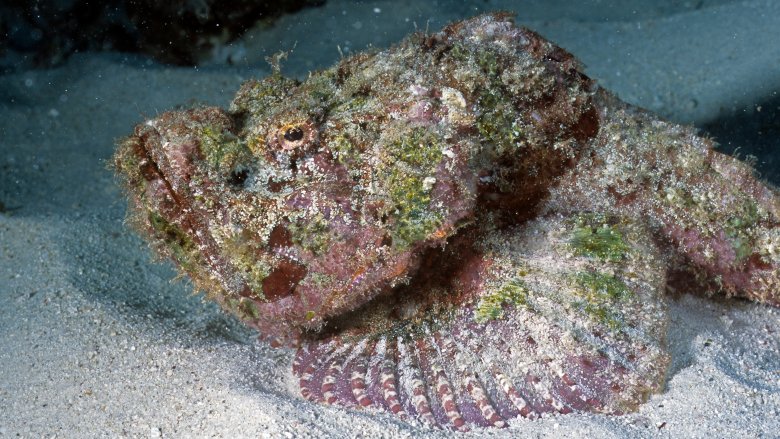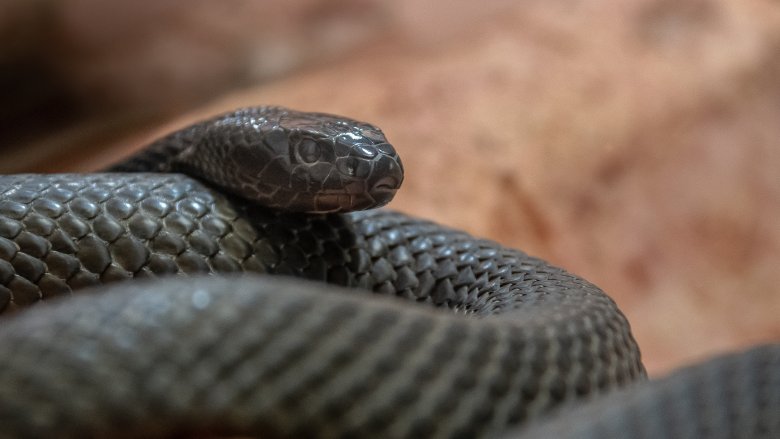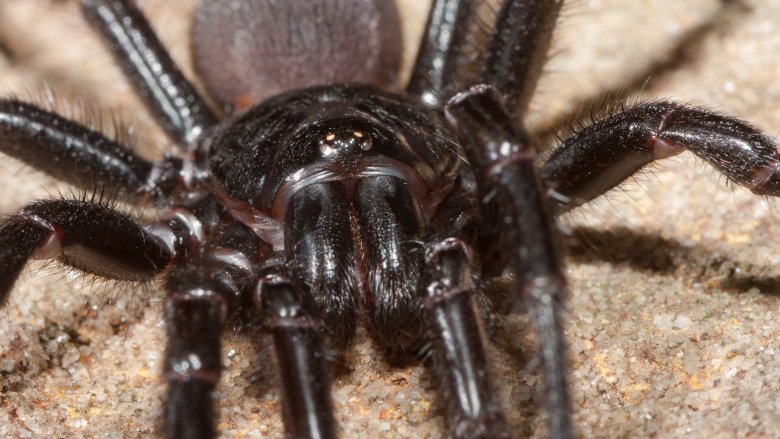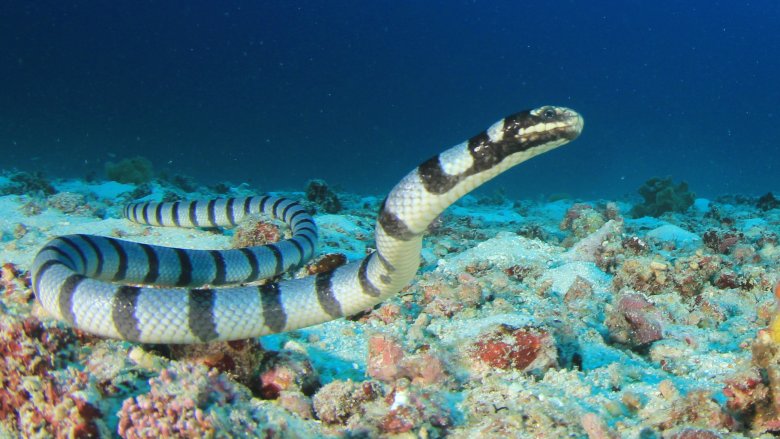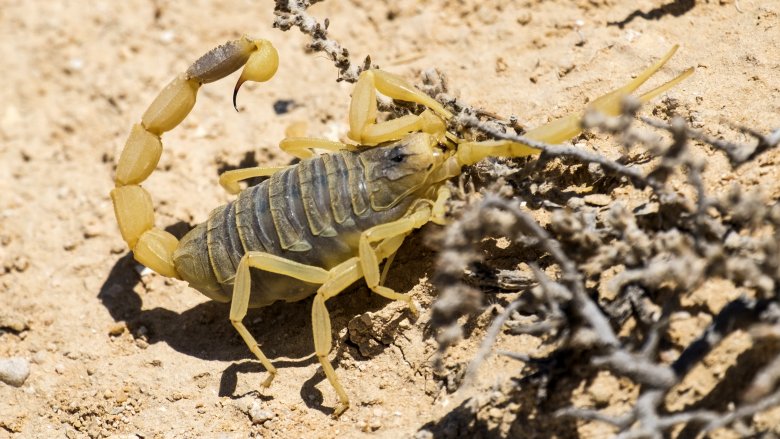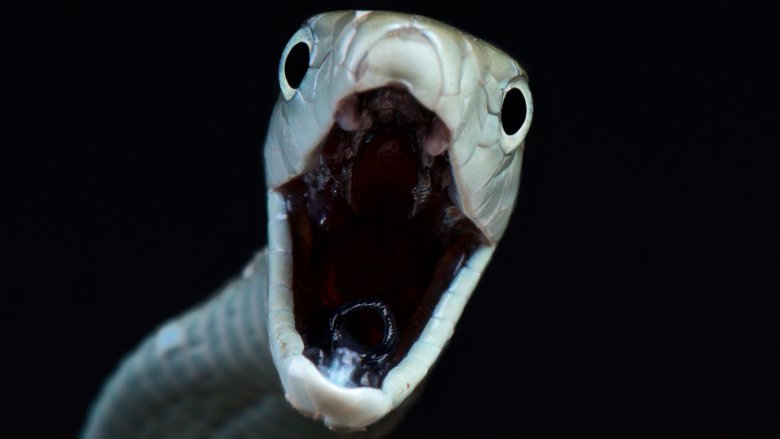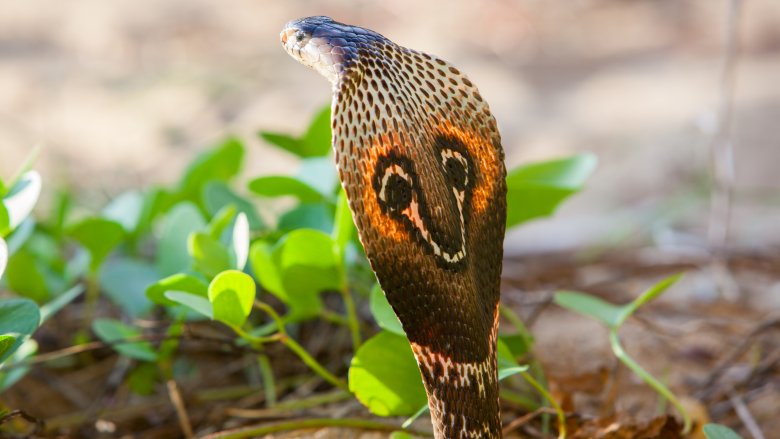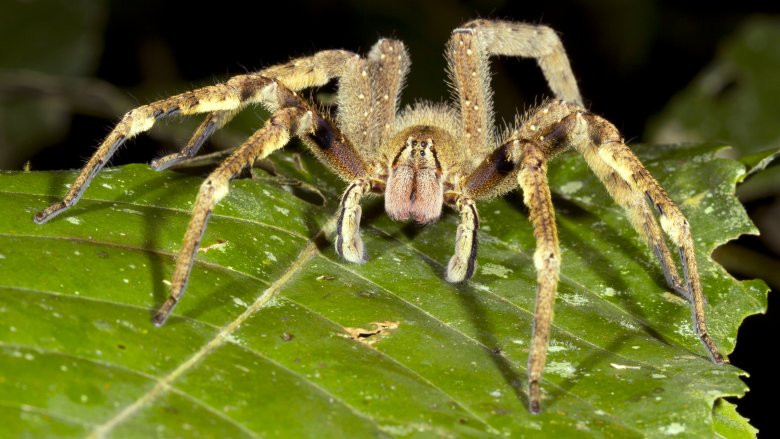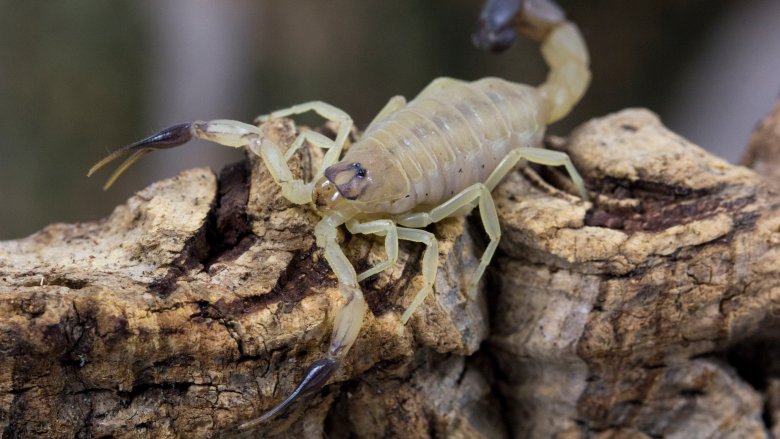These Are The Most Venomous Creatures In The World
Guess what? Rattlesnakes aren't poisonous. It's true! You could eat rattlesnake meat for breakfast, lunch, and dinner, and you'd never get sick, unless you count "sick of eating rattlesnake meat."
Rattlesnakes are venomous, though. What's the difference? A poisonous substance is a toxin that kills you or makes you sick after you eat it, absorb it through your skin, or inhale it. A venom, on the other hand, is a toxin that's delivered by bite or sting. Venom will make you sick or kill you when it enters your bloodstream. So a rattlesnake is venomous, but it's not poisonous. Similarly, a poison dart frog is poisonous, but it's not venomous.
With all that out of the way, we've got to ask the question ... what are the most venomous animals on the planet? Which creatures could murder you in minutes with just a simple sting or a tiny bite? Well, from sea-dwelling beasts to eight-legged arachnids, these are some of the most venomous creatures in the world.
This tiny thing is venomous and poisonous
So now that we've spent a lot of time being particular about the difference between "poisonous" and "venomous," you should know that it's possible for an animal to be both poisonous and venomous. One such example is the blue-ringed octopus, which lives off the coast of Southern Australia, and by the way, you should also know that a disproportionately large number of venomous creatures are found on or close to Australia. So while it might seem like a nice place to visit, pretty much the entire continent wants you dead.
Anyway, according to Marine Bio, the blue-ringed octopus is considered the most deadly creature in the cephalopod family. It's small — the adults are golf ball-sized — and they don't show their rings unless they're alarmed, which makes them delightfully easy to not see while you're swimming around in the reef or sticking your hands in a tide pool.
So what's it like to be the victim of a blue-ringed octopus? Well, its venom, called tetrodotoxin, is over 1,000 times more potent than cyanide, and it carries enough of the stuff around with it to kill 26 human beings. There's no known antidote, and the toxin kills you by paralyzing all your muscles (including your heart and lungs). It might be comforting to know, though, that you can be saved with immediate resuscitation and 24 hours of heart massage and artificial respiration. Anyone wanna go snorkeling?
Faster than a speeding stack of paperwork
It's tough to be a predator, but it's even tougher to be a predator when you move like time at the DMV and your prey moves like a car finally driving away from the DMV. Such is the life of a cone snail.
So how does the cone snail survive? Unlike couch potato humans who couldn't hunt and kill prey if it regularly came out of the TV set, the cone snail can't just go down to the Safeway and buy itself a nice, not-moving piece of beef. Instead, it has evolved to have terrifyingly potent venom as a matter of necessity. According to National Geographic, the fish it eats are fast, and if it had venom that didn't work immediately, the fish might swim away to die in a hole somewhere, and then all that venom would be for nothing. Of course, once the cone snail strikes, the fish is paralyzed instantly.
The most deadly of all the cone snails is the Geographic cone snail, which lives in the tropical Indo-Pacific region of Australia. Fortunately, they'll only tangle with human beings if they're stepped on or if someone goes, "Ooh look at the pretty shell," and tries to pick one up. There's no antivenin for cone snail venom, so survival depends on receiving medical care until the toxin wears off.
Stay away from the box jellyfish
If you're visiting Australia, it might be a good idea to stay out of the water. Why? Well, you might run into one of the most venomous creatures in the world. The box jellyfish is an ethereally beautiful and potentially deadly creature. According to National Geographic, the box jellyfish evolved a super potent venom because it needs to kill its prey instantly, or its prey might seriously mess up its tentacles.
Box jellyfish venom attacks the heart and nervous system, and it's painful, too. Some victims die of shock or heart failure before they can even make it back to shore. The box jellyfish delivers its venom with darts that are located on its tentacles, and here's the terrifying part — on a large box jellyfish, there are billions of venom-delivering cells on each tentacle ... and up to 180 yards of tentacles. In Australia, the species called Chironex fleckeri can kill a person in one minute, and over the past century, that species has killed at least 100 people in Australia alone. But they don't just live inAustralia. You can find box jellyfish throughout the Indo-Pacific region, so maybe just don't ever swim at all, like ever.
Don't go snorkeling without concrete shoes
In the waters of Australia lives a creature unimpressively called a "stonefish," which does look an awful lot like a rock. And yet, it's the most venomous fish on Earth. So in case you needed a reason to not put your feet down while swimming in Australia, well, there you go.
According to Oceana, the stonefish has a venom that can kill an adult human being in less than an hour. But unlike a lot of animals on this list, the stonefish evolved venom not so it could be a more effective predator, but so it could protect itself from predation. Stonefish have other ways to avoid predators, too, including the super creepy ability to keep totally still on the sea floor. Plus, there's that scarily effective camouflage, which helps keep them safe from predators and helps them ambush their prey. Besides being the most venomous fish in the sea, stonefish are also probably the laziest. They can just lie in wait, invisible, and ambush their prey as it practically swims into their mouths. Of course, this is bad news if you're just walking along, minding your own business, and you accidentally step on one of these guys.
So yeah, if you're going to swim in Australia you should put on a pair of concrete shoes. Sure, you might drown, but that sounds a lot better than stepping on a stonefish.
The most venomous snake in the world has never actually killed anyone (to our knowledge)
The inland taipan is quite possibly the most venomous snake in the world, but that doesn't necessarily mean it's the most dangerous snake in the world. A resident of Australia, the taipan is actually very shy, rarely seen, and during the day, it's only active during a very short period of time. It also lives in a remote part of Queensland, where not a lot of people go, so it's not like you have to worry that you're going to find one curled up in your shoe or anything. In fact, snake experts say it's quite docile to handle, so they can just go ahead and do that, then.
If you do get bit by an inland taipan, though, you're probably going to be in trouble. According to the Australian Museum, this snake's venom contains a "spread factor," which actually helps your body to absorb it faster, so that's awesome. And one bite contains enough venom to kill 100 human beings. But on the flip side, only a few people have ever been bitten, and they were able to receive prompt medical care, so they all survived. In other words, this snake is something of a novelty on this list. It's possibly the most lethal serpent in the world, but so far, it hasn't ever actually been lethal to anyone (that we know about).
This venomous creature looks like something from a horror movie
Australia doesn't have a monopoly on venomous spiders. There are venomous arachnids all over the world. Even America has venomous spiders, but black widows and brown recluses aren't aggressive and rarely bite. If you live in Sydney, though ... Sydney funnel-web spiders are not only venomous, they're also really mean. A funnel-web spider will rear up on its back legs sort of like an Alien facehugger when it's provoked, and in this context, "provoked" means you looked at it funny.
The Sydney funnel-web spider is in the Guinness Book of World Records as the world's most venomous spider. It can deliver a venom capable of killing a human being in 15 minutes, but weirdly, it can't kill a cat or a dog. According to Australian Geographic, the venom was an "evolutionary accident," which evolved to be toxic to invertebrates but also, by some seriously unfair freak of nature, ended up also being toxic for primates. Pets can neutralize the toxin in about 30 minutes, so it's only people who have anything to fear from the funnel-web spider. So thanks for that one, nature. Thanks a lot.
The banded sea krait is a real-life sea monster
According to Forbes, there are 70 known species of sea snake, and 30 of them live in the waters off Australia, so that's bad news for anyone in the Land Down Under. The most venomous sea snake is the banded sea krait, which mostly haunts the Indian Ocean, although specimens have been found in Queensland, New South Wales, and Victoria on the Australian mainland.
The banded sea krait is truly horrific to behold. It's already scary enough that some snakes can raise themselves off of the ground to make themselves appear threatening at eye level, but imagine one that goes totally 3D as it cruises through the water towards your vulnerable body parts.
The banded sea krait hunts in the water, but it digests on land. That's where it reproduces, too, so yes, it can kill you on land or sea. Fortunately, most sea snakes — the banded sea krait included — are docile and prefer not to bite humans unless they're provoked. Most bites occur when fishermen accidentally haul them up in their nets, so it's probably a good idea to just toss the net instead of messing around with one of these sea monsters.
This thing has 'death' right in its name
If you travel to the deserts and dry scrublands of the Middle East and North Africa, that's where you'll find the deathstalker, which is widely regarded as one of the most dangerous scorpions in the world. How dangerous? Well, that's the problem, really. In rural Africa, scorpion stings aren't always tended to by a doctor, and some deaths are likely to go unreported. But according to Medscape, it's thought that worldwide, there are roughly 1.2 million scorpion stings every year and around 3,250 deaths, and the deathstalker is definitely responsible for some of those casualties.
The deathstalker's venom contains neurotoxins, and if you're stung by one, it can affect your heart and potentially cause pulmonary edema, which is a buildup of fluid in the lungs. Weirdly, though, the deathstalker is not at the top of its food chain. The Hemprich's long-eared bat preys on the deathstalker, and it's so resistant to the venom that it doesn't even seem to care that it's being stung as it eats its dinner.
This snake's mouth is a black, gaping chasm of death
As scary as rattlesnakes are, if you're ever in the lair of a super villain, and he gives you a choice to be bitten by a rattlesnake or a black mamba, take the rattlesnake. Rattlesnakes can be deadly, but they don't actually kill that many people. The black mamba, on the other hand, is considered a top killer in southern and eastern Africa. No one is really sure how many people get killed by black mambas every year because snakebite deaths in rural Africa often go unreported.
However, it takes just two drops of black mamba venom to kill a person, and death only takes about 20 minutes. According to National Geographic, there is an antivenin, but it's not widely available, and if a bite victim doesn't have access to it, the fatality rate is roughly 100 percent.
The black mamba gets its name from the gaping hole of impenetrable death in the middle of its face. When a black mamba opens its mouth, you can see nothing but darkness. And because just having super toxic venom evidently didn't satisfy nature when she created this terrifying, terrifying creature, the black mamba is also the world's fastest land snake, and at up to 14 feet long, it's the longest venomous species in Africa. When it decides to strike, it does so repeatedly, injecting large quantities of venom with each bite. Also, its head is shaped like a coffin. That is all.
The king of all snakes is a terrifying creature
When people think about deadly snakes, they generally imagine these guys slithering around in Australia or Africa. But Asia is full of murderous serpents, too. In fact, southern China and India are home to the king cobra, which is the world's longest venomous snake. According to Live Science, a king cobra can grow to be 18 feet long, though 10 to 13 feet is more average. And because a king cobra can lift the front third of its body when it feels threatened, it can stare you down eye to eye like a playground bully and keep moving forward all the while. So that's terrifying, but king cobras have the bite to back up their bark. In fact, a single bite from a king cobra is capable of delivering enough neurotoxin to kill 20 adult humans or an elephant.
The good news is that king cobras aren't especially aggressive. They prefer to avoid humans rather than confront them. But if they feel trapped, well, let's just say you don't ever want to be eye to eye with a king cobra.
This spider sometimes stows away in bunches of bananas
Do you like bananas? If not, great. If so, prepare to avoid bananas for the rest of your life because this terrifying spider lives among those yellow fruits and occasionally hitches a ride on them to your local supermarket.
According to LiveScience, the Brazilian wandering spider belongs to the genus Phoneutria, which literally means "murderess," so that's really all you have to know. But if for some reason you do want more information, a bite from this spider causes heart problems, abdominal cramping, nausea, vertigo, hypothermia, convulsions, and shock. On the flip side, these spiders usually don't inject a lot of venom, so most people unlucky enough to be bitten by one won't experience all those symptoms.
And the good news is, some of the spiders that have infiltrated banana shipments ended up not being Brazilian wandering spiders. Many of them, in fact ... but notably, not all. So next time you're preparing breakfast, maybe try enjoying your cereal sans banana.
The most venomous scorpion on the planet
No one likes to be called fat, and this particular scorpion must hate it a lot because it's developed a venom lethal enough to land it in the Guinness Book of World Records, probably so it can kill anyone commenting on its weight.
The Tunisian fat-tailed scorpion might look like an evil murder monster straight from the pits of hell, and well, that's because it is. Adults can grow to be nearly four inches in length, and they pack a whole lot of power in their wicked tails. As it turns out, the fat-tailed scorpion is believed to be responsible for 80 percent of scorpion stings in North Africa. Crazier still, this eight-legged menace can claim 90 percent of all scorpion-related deaths in the region. So yeah, you definitely don't want to mess with this dude.
Of course, if you just can't resist the allure of owning one of the most venomous creatures in the world, then it will run you about $40.
